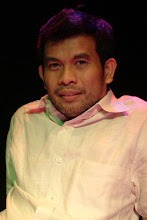Retorika
KL Fringe Festival ‘08
July 11-27, 2008.
Rhetoric – Retorika: KL Fringe Festival adalah sebuah ide yang bermain dengan istilah Retorika atau Rhetoric itu sendiri, yang seringkali merujuk kepada slogan-slogan, terutamanya dari pihak kerajaan seperti “Majulah Sukan Untuk Negara”, “Filem Kita Wajah Kita”, “Sedia Berkhidmat”, “Berkhdimat Untuk Negara”, “Bahasa Jiwa Bangsa”, “Seni Untuk Semua”, “Belia Benci Dadah”, “To Love Malaysia is To Know Malaysia”, “Kepimpinan Melalui Tauladan” dan sebagainya. Kemudian lahir pula ide yang menggabungkan antara Retorika dan Kata-kata, tetapi sekaligus bermain dengan ide untuk kembali kepada apa yang telah diucapkan atau dijanjikan sehingga melahirkan Retorika, yang sekaligus adalah merujuk kepada rekaan kata-kata yang akhirnya menjadi sebuah retorika semata-mata. Samada untuk memanggil khalayak atau untuk menjual barangan.
What’s Rhetoric?
Rhetoric (from Greek meaning orator/ teacher) is generally understood to be the art (Latin) or technique (Greek) of persuasion through the use of oral, visual, or written language. A rhetorical question is a question which is asked to have a persuasive effect, rather than to elicit an answer.
The definition of rhetoric has expanded greatly since it emerged as a field of study in universities. In this sense, there is a divide between classical rhetoric (with the aforementioned definition) and contemporary practices of rhetoric which include the analysis of written and visual texts. In contraposition to scientific debates, rhetorical arguments, as in politics or even justice, do not make use of demonstrable or tested truths but resort to fallible opinions, popular perceptions, transient beliefs, chosen evidence or evidence at hand (like statistics), which are all properly called commonplaces as they help establish a commonality of understanding between the orator or rhetor and his/her audience.
Rhetoric is said to flourish in open and democratic societies with rights of free speech, free assembly, and political enfranchisement for some portion of the population. However, celebratory (or epideictic) rhetoric, along side deliberative rhetoric, is just as important an element of tyrannical regimes or dogmatic (religious and otherwise) public entities that are not open to debate on an equal footing.
So while rhetoric has traditionally been thought of being involved in such arenas as politics, law, public relations, lobbying, marketing and advertising, the study of rhetoric has recently entered into diverse fields such as humanities, religion, social sciences, law, science, journalism, history, literature and even cartography and architecture. Every aspect of human life and thought that depends on the articulation and communication of meaning can be said to involve elements of the rhetorical.
Rhetoric is not only a method for training effective communicators (rhetors); as a discipline for advanced study, it is a method for understanding on a theoretical as well as a practical level how humans use language ("discourse") to alter or shape our understanding of reality. Every text -- be it advertisement, lecture, speech, letter, blog, or chat -- inhabits a given discourse environment, hence the term discourse analysis. Rather than providing a particular method, discourse analysis is a way of approaching and thinking about a problem; neither a qualitative nor a quantitative research method, but rather a questioning of the basic assumptions of quantitative and qualitative research methods.
Despite the fact that the populations of China and India make up over one quarter of the population of the Earth, and that "60% of humanity lives in the Pacific Basin," and that both countries have a history that in some cases predates that of Greece and the ancient Near-East there is not a voluminous body of work on the rhetoric of Asia. The Rhetoric Society Quarterly in its almost twenty years of publication has devoted one article to Asian rhetoric and has published one bibliography devoted to the subject of Asian Rhetoric. Most of the references to be found in this bibliography are to speeches and the current writings of figures such as Mao Tse-Tung and other recent figures that have played a prominent part in the Asian political scene. The Bhagavad Gita is an extended rhetorical piece which forms part of a larger epic, the Mahabharata and the larger unit of which it is a part has sometimes been compared to the Iliad both in terms of length (the Mahabharata is longer) and in terms of its centrality to Indian culture, however, because of the Gita's extensive length it is not suitable for a detailed analysis and there seems to be no other primary example from India that could serve as a paradigm for that country's rhetorical use of ethos.
The situation with respect to devising a paradigmatic oration for the rhetoric of China is even worse in that the central works of the Confucian tradition are not primarily concerned with rhetoric but with ritual, poetry, and ethical customs. Popular works that provide paradigms might include the six classic novels (San Kuo Yen Yi ( Romance of the Three Kingdoms); Shui Hu Chuan ( The Story of the Water Margin); Hsi Yu Chi ( Pilgrimage to the Western Regions); Chin P'ing Mei ( Golden Vase of Plum Flowers); Ju-lin Wai Shih ( Unofficial History of Officialdom); and Hung Lou Meng ( Dream of the Red Chamber)), however, these all come during the post-Classical period and the earliest.

No comments:
Post a Comment